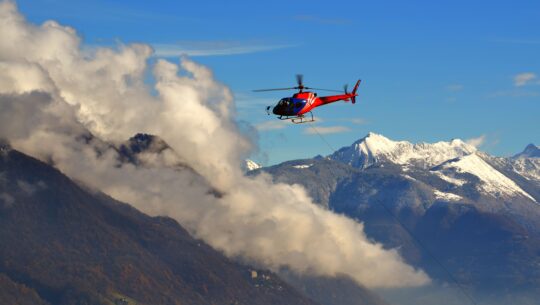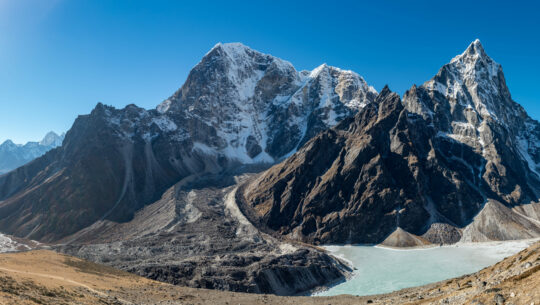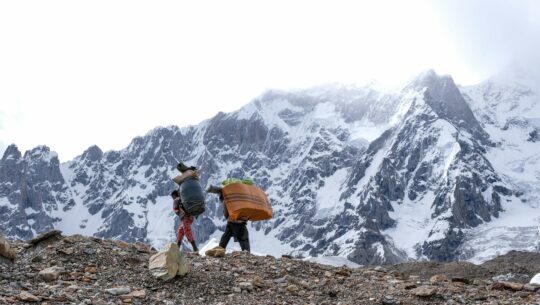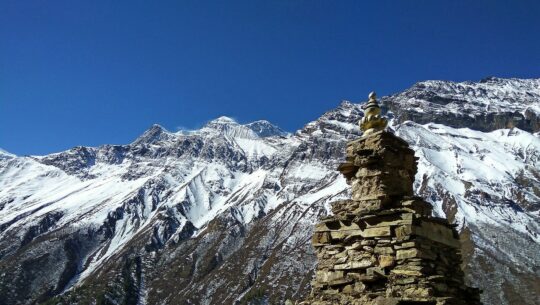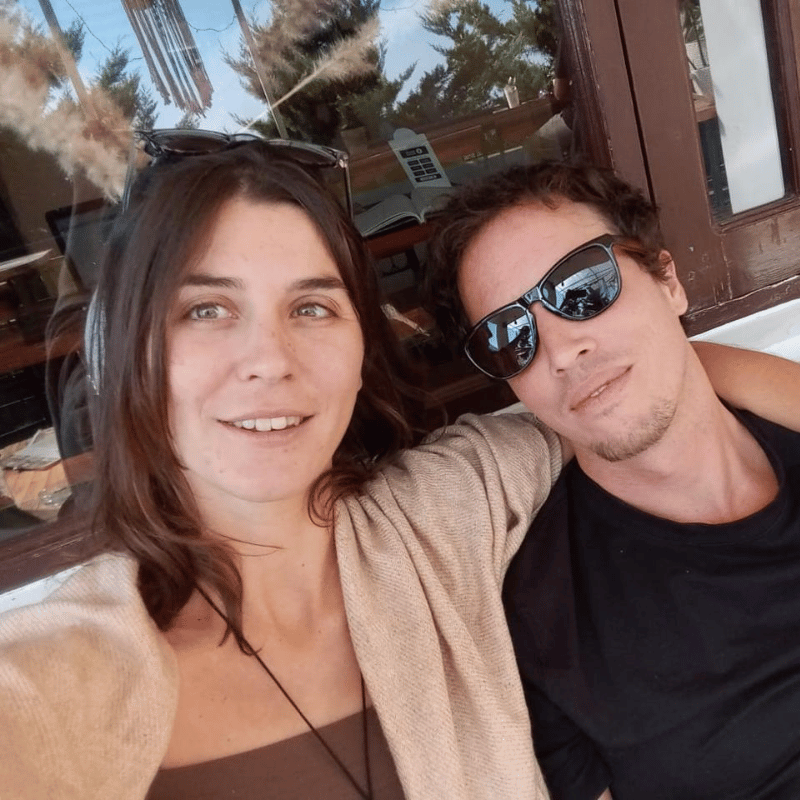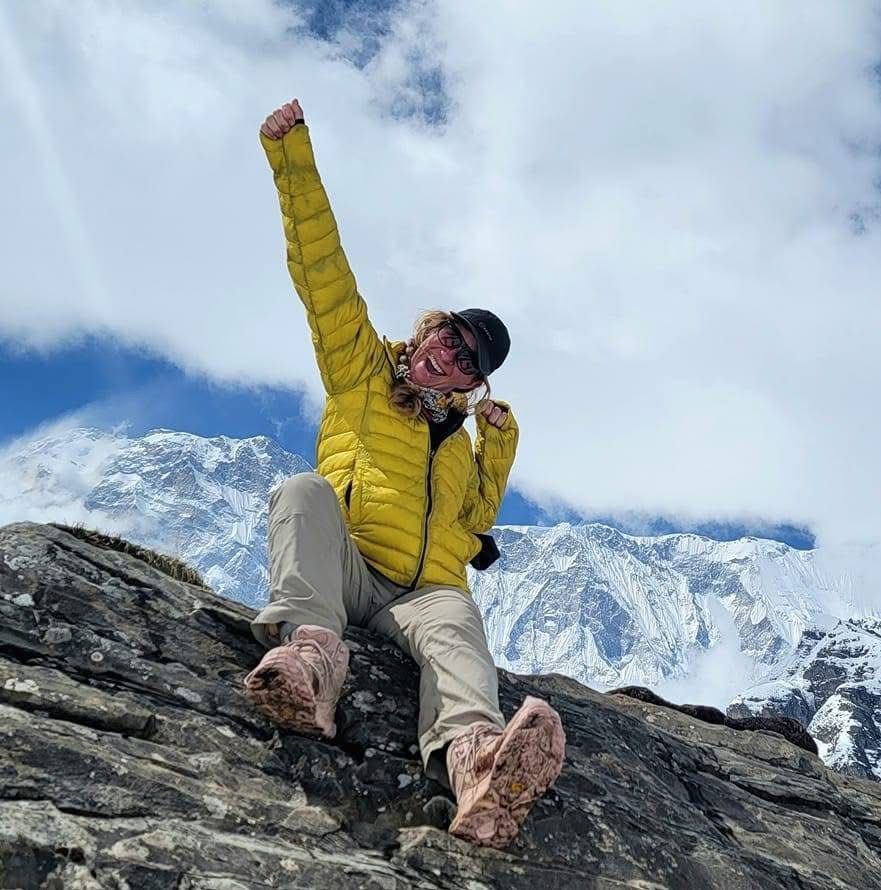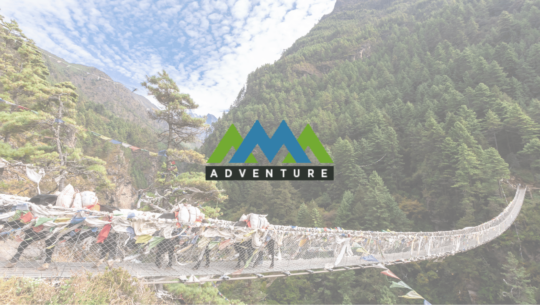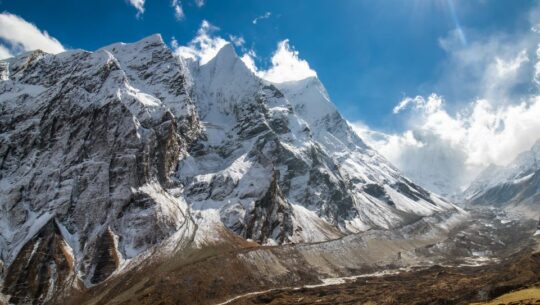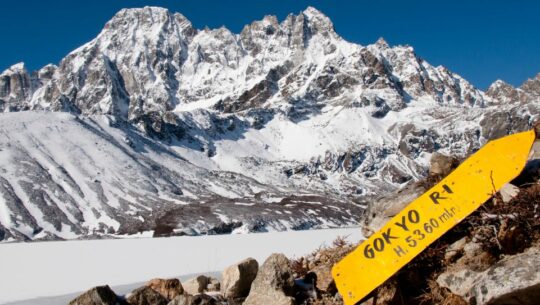
Everest Express Trek- 11 Days
Begin an exciting journey to the base of Mount Everest, where quiet trails, vibrant local culture, and stunning views of the Himalayas make every step unforgettable.
Nepal
11 Days
Moderate
5,545 m
Autumn and Spring
Tea Houses & Hotels
Included
Kathmandu
USD 2999
Trip Highlights
- Roam the narrow alleys of bustling Kathmandu, discovering landmarks such the Monkey Temple.
- Watch the sun set over Mount Everest and Lhotse from the Kala Patthar viewpoint, one of the most spectacular vantage points in the region.
- Immerse yourself in Sherpa culture, learning about the traditions and lifestyles of the people who call the Himalayas home.
- Sip tea or coffee at one of the world’s highest markets in Namche Bazaar, a vibrant hub for trekkers and locals alike.
- Helicopter to the foot of the Khumbu Icefall, ground zero for all Everest expeditions, for a close-up view of this iconic glacier.
Trip Overview
Experiencing Everest Base Camp by helicopter is an increasingly popular option for tourists who wish to witness the majestic beauty of the Himalayas without the rigors of a multi-day trek. This method involves first flying into Lukla Airport, a gateway to the Everest region, followed by a thrilling helicopter ride directly to Everest Base Camp. This one-day tour offers stunning aerial views of the surrounding mountains, including the iconic peak of Mount Everest, providing a convenient and exhilarating experience for those with limited time or physical constraints.
Everest Base Camp Trek with Helicopter Return
For those seeking a more immersive experience, the Everest Base Camp Trek with a helicopter return combines the adventure of trekking to the base camp with the convenience of flying back. This trek typically spans 5-10 days, depending on the pace of the group or individual, allowing hikers to fully engage with the breathtaking landscapes and rich culture of the region. Upon reaching the base camp, trekkers can opt for a helicopter ride back, which takes approximately an hour. This hybrid approach offers the best of both worlds: the achievement and beauty of the trek and the thrill of a helicopter flight over the Himalayas.
Outline Itinerary
- Day 1: Arrival in Kathmandu (1,300 m/4,264 ft)
- Day 2: Phakding to Namche Bazaar (3,440 m/11,286 ft), 6-7 hrs
- Day 3: Trek to Namche Bazaar (3,440 m/11,286 ft) from Phakding, 5-6 hrs
- Day 4: Acclimatization day at Namche Bazaar. Hike to Hotel Everest View (3,880 m/12,730 ft) and back, 4-5 hrs
- Day 5: Trek to Tengboche (3,860 m/12,664 ft) from Namche Bazaar, 5-6 hrs
- Day 6: Trek to Dingboche (4,410 m/14,469 ft) from Tengboche, 6-7 hrs
- Day 7: Acclimatization Day at Dingboche. Hike to Nangkartshang Peak (5,083 m/16,676 ft), 4-5 hrs
- Day 8: Trek to Lobuche (4,910 m/16,109 ft) from Dingboche: 5 to 6 hrs
- Day 9: Trek to Everest Base Camp (5,364 m/17,598 ft) & then back to Gorak Shep, 8-9 hrs
- Day 10: Hike up to Kalapatthar (5,555 m/18,225 ft) and then, descend to Gorak Shep (5,164 m/16,942 ft), 4-5 hrs
- Day 11: Departure
Detailed Itinerary
Day 1: Arrival in Kathmandu (1,300 m/4,264 ft)
Arrival at Tribhuvan International Airport in Kathmandu (1,400 m/4,593 ft) and transfer to hotel.
When you arrive at Tribhuvan International Airport in Kathmandu, our representative will be there to greet you with a warm welcome. From the airport, you’ll be transferred to your hotel in a private tourist vehicle.
Later, we’ll hold a pre-trip meeting where you’ll get to meet your trekking guide. This is a great time to go over any questions or details about your upcoming adventure in the mountains.
Note: If you arrive in Kathmandu before 4 PM, the pre-trip meeting will take place at our office. If you arrive later in the evening, we’ll conduct the meeting at your hotel. Please make sure to bring two passport-sized photos and a clear copy of your travel insurance policy to the meeting.
These documents are essential for arranging your trekking permits and other necessary paperwork. You’ll also need to clear the remaining balance of your trip cost and complete the mandatory trip form and non-liability disclaimer before beginning your trek.
Overnight at a 4-star Hotel.
Max Altitude
: (1,400 m/ 4,593 ft)
Meals
: Not Included
Day 2: Phakding to Namche Bazaar (3,440 m/11,286 ft), 6-7 hrs
Flight to Lukla (2,840 m/9,318 ft) from Kathmandu- 35 minutes or drive to Manthali-5 to 6 hours and a 20-minute flight to Lukla, and then trek to Phakding (2,610 m/8,562 ft)- 3 to 4 hours. Overnight at a guesthouse.
Flight to Lukla During Peak and Off-Peak Seasons
Manthali to Lukla (March, April, May, October, and November)
During the busy trekking months- March, April, May, October, and November, flights to Lukla are redirected to operate from Manthali (Ramechhap) due to heavy air traffic at Kathmandu airport. Manthali is about a 5 to 6 hour drive from Kathmandu. On this travel day, we start very early, around 1:30 to 2:30 AM, with a shared tourist vehicle drive to Manthali airport. From there, you’ll take a short 20-minute flight to Lukla.
Kathmandu to Lukla (January, February, June, July, August, September, and December)
During the quieter seasons- January, February, June through September, and December, flights to Lukla generally depart directly from Kathmandu. However, final flight arrangements depend on the airlines and the number of travelers. On this day, you’ll start your morning around 5 to 6 AM, and our staff will transfer you to the domestic terminal for a 35-minute flight to Lukla.
Optional Helicopter Flight
If you’d like to skip the long drive to Manthali during peak season, you can book a direct helicopter flight from Kathmandu to Lukla. The cost is USD 550 per person (based on a group of five passengers sharing). This is the fastest and most comfortable alternative.
Trekking Begins – Lukla to Phakding
The night before your flight, pack your duffel bag (10-12 kg limit) with all necessary trekking items. Your journey begins early with a scenic flight to Lukla’s Tenzing-Hillary Airport, known for its thrilling approach. Upon landing, you’ll be welcomed by your porter-guide, who will help organize your gear. After a short tea or coffee break, the adventure officially begins.
The trail gently descends through the charming village of Cheplung, offering your first views of majestic peaks like Kusum Khangkaru and Nupla. You’ll walk alongside the Dudh Koshi River, passing through forested areas and traditional settlements. Shortly after Chaurikharka (2,713 m), you’ll join the main path to Namche Bazaar and pass through Ghat, where prayer wheels and mani stones bring a peaceful, spiritual feel to the trail.
After about 3 to 4 hours of trekking, you’ll arrive in Phakding, a tranquil village by the river. This cozy place is perfect for your first night in the Khumbu region- ideal for rest, a hearty meal, and enjoying the calm of the mountains.
Travelled Distance
: 10.5 km/ 6.5 miles
Max Altitude
: Lukla (2,840 m / 9,318 ft), Phakding (2,610 m / 8,563 ft)
Trip Duration
: 35 min from Kathmandu, or 20 min from Manthali (after 5 to 6 hrs drive)
Meals
: Breakfast, Lunch, and Dinner
Day 3: Trek to Namche Bazaar (3,440 m/11,286 ft) from Phakding, 5-6 hrs
After enjoying a good breakfast, we begin our journey alongside the peaceful Dudh Koshi River, crossing several high suspension bridges that gently sway above the glacial waters below.
The trail leads us through a series of picturesque villages-Toktok, Benkar, Chomoa, and Monjo, each offering a glimpse into the daily life of the Sherpa people, set against a backdrop of stunning Himalayan peaks.
At Monjo (2,840 m), we stop to have our permits checked at the entrance to Sagarmatha National Park, officially entering the Everest region.
From there, we descend to the riverside village of Jorsalle (2,740 m), where we’ll stop for a tasty lunch, surrounded by fresh mountain air and the soothing sound of flowing water.
After lunch, the trail becomes more adventurous. We cross two more suspension bridges, including the iconic Hillary Bridge- one of the highest and most dramatic on the route.
The path then follows a typical “Nepali flat” section, with some gentle ups and downs, before leading into a steep uphill climb to Top Danda. From here, you’ll be treated to your first clear view of Mount Everest (8,848 m), along with stunning sights of Lhotse, Nuptse, Thamserku, and Taboche- an awe-inspiring moment for every trekker.
The final approach to Namche Bazaar (3,440 m) is lined with colorful prayer flags, mani stones, and chortens, filling the trail with spiritual energy.
After about an hour of walking, we arrive in Namche, the lively heart of the Khumbu region and the cultural hub of the Sherpa community.
Known for its friendly atmosphere, local markets, and inviting cafés, Namche is a great place to relax and recharge. You can stroll through its vibrant streets, visit the local museum, or simply enjoy a warm cup of Sherpa tea while admiring the breathtaking mountain views.
We’ll spend the next day here to acclimatize properly, preparing our bodies for the higher altitudes ahead.
Max Altitude
: Namche Bazaar (3,440 m / 11,286 ft)
Trip Duration
: 5 to 6 hours
Meals
: Breakfast, Lunch, and Dinner
Day 4: Acclimatization day at Namche Bazaar. Hike to Hotel Everest View (3,880 m/12,730 ft) and back, 4-5 hrs
Today is all about helping your body adjust to the altitude while enjoying the beauty of Namche Bazaar and its surroundings.
After breakfast, we hike up to Syangboche and the famous Hotel Everest View (3,880 m). Along the way, you’ll get stunning views of Everest, Lhotse, Nuptse, Ama Dablam, and other Himalayan peaks. At the hotel, take a break, enjoy the scenery, and maybe sip a warm drink while soaking in the views.
We then head back down to Namche, where you’ll have the afternoon free. Explore the lively town-visit local shops, enjoy a cafe, or check out the Everest Museum to learn more about Sherpa culture and mountain history.
This acclimatization day mixes light hiking with plenty of time to rest and explore.
Max Altitude
: 3,880 m
Trip Duration
: 4-5 hrs hike
Meals
: Breakfast, Lunch, Dinner included
Day 5: Trek to Tengboche (3,860 m/12,664 ft) from Namche Bazaar, 5-6 hrs
After breakfast, we leave Namche and begin a gradual ascent along a comfortable trail.
We pass through scenic Sherpa villages like Kenjoma, Sanasa, and Leushyasa, each offering glimpses of daily life in the mountains. Our morning walk ends at Phunke Tenga, where we stop for lunch.
After crossing a suspension bridge over the Imja Khola, we start a steady climb through beautiful rhododendron forests, especially colorful in spring.
By afternoon, we reach Tengboche, home to the region’s most important monastery. The peaceful setting, often filled with the sound of monks chanting, is matched by breathtaking views of Everest, Lhotse, Nuptse, and the iconic Ama Dablam.
Max Altitude
: 3860 m
Trip Duration
: 5-6 hrs
Meals
: Breakfast, lunch, dinner included
Day 6: Trek to Dingboche (4,410 m/14,469 ft) from Tengboche, 6-7 hrs
After a restful night in Tengboche, we begin our scenic walk to Dingboche, a beautiful Sherpa village nestled in the Imja Valley. Today’s trek is full of dramatic mountain views and rich cultural moments.
We descend gently through rhododendron forests to Debuche, then gradually climb higher, where the stunning Ama Dablam dominates the skyline. Known as the “Queen of the Himalayas,” this iconic peak offers ever-changing views that are truly mesmerizing.
Passing through Pangboche, we visit the region’s oldest monastery before stopping for lunch in the quiet village of Somare. The trail continues through Orsho and Kalapani, with classic Himalayan scenes-stone houses, grazing yaks, and trails lined with prayer flags.
The final climb brings us to Dingboche (4,410 m), a perfect spot for acclimatization. Surrounded by towering peaks like Lhotse and Island Peak, the village offers some of the finest views on the trek.
Max Altitude
: 4,410 m/14,469 ft
Trip Duration
: 5-6 hrs
Meals
: Breakfast, Lunch & Dinner
Day 7: Acclimatization Day at Dingboche. Hike to Nangkartshang Peak (5,083 m/16,676 ft), 4-5 hrs
At 4,410 meters, Dingboche is a key acclimatization stop on the way to Everest Base Camp. Surrounded by stunning peaks and peaceful highland scenery, it’s the perfect place to rest and adjust to the altitude.
Today, we hike to Nangkartsang Peak (5,083 m), offering one of the best panoramic views of the trek. Along the way, we’re rewarded with a sweeping Himalayan vista- Everest, Lhotse, Makalu, Ama Dablam, and more rise all around in an unforgettable 360° display.
After the hike, we return to Dingboche where cozy teahouses, warm ginger tea, and mountain charm welcome us back. The afternoon is free to relax, explore the village, and take in the incredible surroundings.
This rest day blends altitude adaptation with breathtaking scenery, preparing us for the heights ahead.
Trip Duration
: 4-5 hrs
Meals
: Breakfast, Lunch & Dinner
Day 8: Trek to Lobuche (4,910 m/16,109 ft) from Dingboche: 5 to 6 hrs
The day starts with a beautiful sunrise lighting up Mount Ama Dablam as you enjoy breakfast. The trek to Lobuche offers stunning views and rich mountaineering history in the Khumbu region.
The path gently climbs through moraines, with sights of Cholatse and Taboche. You’ll pass glacial lakes and the Khumbu Glacier’s impressive moraine. At Thukla, take a break for lunch before ascending Thukla Pass, where memorials honor climbers lost on Everest.
From Lobuche, you’ll see Mount Pumori and Nuptse’s towering faces. As the sun sets, the peaks glow with fiery colors reflected in clear streams- a perfect end to the day.
This steady trek challenges both body and mind, bringing you closer to Everest Base Camp and the heart of the mountains.
Max Altitude
: Lobuche (4,910 m)
Trip Duration
: 5-6 hrs
Meals
: Breakfast, Lunch, Dinner
Day 9: Trek to Everest Base Camp (5,364 m/17,598 ft) & then back to Gorak Shep, 8-9 hrs
Today is the day you’ve been working towards- standing at the foot of Mount Everest. As the sun rises over Lobuche, excitement builds in the cold morning air.
After breakfast, we set off toward Gorak Shep, walking 2-3 hours through some of the most dramatic mountain scenery. Peaks like Pumori, Nuptse, Changri La, and Lingtren rise around us as we move closer to our goal.
At Gorak Shep, the last settlement before Base Camp, we pause for lunch and prepare for the final stretch. With water, snacks, warm clothes, and cameras packed, we head out across the Khumbu Glacier.
Reaching Everest Base Camp (5,364 m) is a powerful moment. The Khumbu Icefall stands nearby, and the towering face of Everest fills the horizon. Trekkers from around the world gather here, united by effort and achievement.
After taking in the views and snapping those unforgettable photos, we return to Gorak Shep for the night. Surrounded by Himalayan giants, you’ll drift to sleep knowing you stood at one of the world’s most iconic places.
Max Altitude
: Everest Base Camp (5,364 m), Gorak Shep (5,190 m)
Trip Duration
: 8-9 hrs
Meals
: Breakfast, Lunch & Dinner
Day 10: Hike up to Kalapatthar (5,555 m/18,225 ft) and then, descend to Gorak Shep (5,164 m/16,942 ft), 4-5 hrs
Early morning hike up to Kalapatthar (5,555 m/18,225 ft) and then, descend to Gorak Shep (5,164 m/16,942 ft) – 4 to 5 hours. Shared helicopter flight from Gorak Shep to Lukla (2,840 m/9,318 ft) – 15 to 20 minutes and to Kathmandu- 45 minutes.
Today’s the moment you’ve been waiting for- standing at Everest Base Camp. We start early from Lobuche, trekking 2-3 hours through stunning mountain views to reach Gorak Shep, the last settlement before Base Camp.
After lunch and a quick gear check, we begin our final push across the Khumbu Glacier. The views are unforgettable- Pumori, Nuptse, and the mighty Everest towering ahead.
Reaching Base Camp (5,364 m) is a proud moment. You’ll soak in the views, snap milestone photos, and feel the reward of your journey.
After taking it all in, we return to Gorak Shep to rest, ending the day with the mountains all around.
Max Altitude
: Everest Base Camp (5,364 m), Gorak Shep (5,190 m)
Trip Duration
: 8-9 hrs
Meals
: Breakfast, Lunch & Dinner
Day 11: Departure
Today is your departure day, marking the end of your Everest Base Camp journey. After a scenic helicopter return, our team will escort you to the airport for your flight home.
If you plan to extend your stay, we can help arrange trips to Chitwan, Lumbini, other trekking routes, or even nearby countries like Tibet, India, or Bhutan.
Meals
: Breakfast
Gallery
What is included
Accommodation
- 4-star hotel in Kathmandu on a twin/double-sharing basis with breakfast
- Guesthouses during the trek (twin-sharing), with attached bathrooms in Lukla, Phakding & Namche
Meals & Drinking Water
- Breakfast, Lunch, and Dinner during the trek
- One hot drink per meal and seasonal fruits
- Farewell dinner on the final night in Nepal
- Purified drinking water throughout the trek (via water filter or purification tablets)
Transportation
- All airport transfers (domestic) by private tourist vehicle
- Round flight between Kathmandu/Manthali and Lukla
- Shared helicopter from Gorakshep to Lukla, then Lukla to Kathmandu
Guide & Support Staff
- Licensed, experienced, English-speaking trekking guide (2 guides for groups of 8 or more)
- Porter support (1 porter per 2 trekkers)
- All staff’s wages, accommodation, meals, insurance, gear, and medication
Permits & Entry Fees
- Sagarmatha (Everest) National Park entry permit
- Pasang Lhamu Rural Municipality entrance fee
- TIMS (Trekkers’ Information Management System) card
Health & Safety
- Comprehensive first aid kit
- Daily health checks with a pulse oximeter to monitor altitude-related symptoms
Extras & Souvenirs
- Duffle/kit bag, and a trip completion certificate
Administrative
- All government taxes and administrative fees
What is Excluded
- Lunch and dinner while in Kathmandu
- International airfare and airport departure tax
- Travel insurance – Must include high-altitude emergency evacuation coverage
- Alcoholic beverages, cold drinks, and bottled juices
- Tips – For trekking staff and drivers (at your discretion)
- Personal trekking gear and equipment
- Single room supplement – Available on request at an extra cost
- Any expenses not mentioned in the Price Includes section
- Nepal Entry Visa
Trip Departure
Ama Adventure arranges both solo and group travel, ensuring amazing experiences with people from all over the world. Before departure, we reconfirm the number of participants in your group. We guarantee all group departure dates even if there’s only one person signed up for the Everest Express Trek. This ensures that your adventure is confirmed regardless of group size.
Difficulty Level
This trek is suitable for individuals with above-average physical fitness. While no special technical skills are required, beginners are welcome. The trek involves significant elevation gains and high altitudes, requiring physical exertion and endurance. Trekkers can expect to hike for 5 to 10 hours daily, with the reward of breathtaking views and personal achievement.
Dates & Price
We ensure departures on all published dates. If these dates don’t align with your plans, we’re happy to assist in setting a customized date. Whether you’re a solo traveler, a couple, a family, or a group seeking private trips, you can tailor-make your adventure. Reach out to us for pricing details or any other queries.
Meals
Throughout our trek, you’ll savor authentic Nepalese dishes alongside international cuisines such as Tibetan, Continental, Italian, and Indian. Breakfast and dinner will be served at the tea houses or lodge menus where we stay overnight, while lunches will be provided en route to our next destination. During the trek, all meals are included. In Kathmandu, breakfast is provided, and special welcome and farewell dinners will be arranged for our guests.
Accomodation
We’ll be accommodated at Standard Hotel in Kathmandu, and the best available teahouses during our trek. Accommodations are based on twin sharing. For those requesting a single room, there will be an additional cost of USD 100. While we aim for rooms with attached washrooms, please note that some tea houses may only have shared washing and toilet facilities. Single rooms are readily available in Kathmandu, Pokhara, and lower-elevation trekking areas, but availability might be limited at higher elevations.
Weather Information
Mountain weather changes a lot with elevation and landscape. Starting in Lukla, you’ll gain height each day, and temperatures will slowly get colder. Days are warmed by the sun, but nights become quite cold. At higher altitudes, nighttime temperatures can drop to the teens or twenties (°F). Mornings usually start with a fleece or jacket, and you can add or remove layers during the day as needed.
Important Notes
We give you a free duffel bag and baseball cap during your pre-trip meeting in Kathmandu. The duffel bag will be used to pack your trekking supplies.
For every two participants, we assign one porter. The duffel bag, which should weigh around 10 kg/22 lbs, will be carried by the porter throughout the walk.
To carry your daily necessities like cash, crucial papers, a water bottle or bladder, a camera, toiletries, sunscreen, a notebook, clothing, etc., you must have your own daypack (with a waterproof cover).
You can store your luggage (non-trekking items) at the hotel in Kathmandu.
Total luggage allotment allowance for the Kathmandu-Lukla flight is 15 Kg/33 lbs including both duffel (10 Kg/22 lbs.) and backpack (5 Kg/11 lbs.)
Down jacket with a hood is a must for altitudes above 4,000 m to keep warm. We provide both a down jacket and a sleeping bag, which must be returned after the trek. In case of loss or damage to these items, the reimbursement cost is USD 200 per item.
Note: Some clothing, especially form-fitting, figure-hugging items made of elastic material (like yoga pants), may offend locals. Therefore, if you choose to wear these clothes for comfort, please make sure to wear something over them.
Packing List
Here’s a suggested packing list to help you get ready for the Everest Express Trek -11 Days. Please take this as a starting point. You’ll need layers of warmer clothing during the winter.
We provide a 75-liter duffel bag for you to use for the trek. It will be given to you during your pre-trip meeting in Kathmandu. The duffle bag is yours to keep.
General
- Four-season sleeping bag (rated to 0°C or lower)
- Sleeping bag liner
- Insulated down jacket
- Daypack (35-45 liters recommended) with rain cover
Upper Body
- Sun hat or cap
- Warm knitted hat or beanie
- Scarf or neck gaiter (Buff recommended)
- Headlamp with extra batteries
- UV-protection sunglasses
Torso
- Moisture-wicking base layers – lightweight for warmer seasons, thermal for colder months
- Two short-sleeve and two long-sleeve trekking shirts made of quick-dry technical fabric
- Windproof and waterproof outer shell or jacket
- Warm fleece jacket or pullover for added insulation
Lower Body
- Thermal base layers – lightweight for warm months, heavier for cold conditions
- Two pairs of durable hiking pants
- Comfortable pants for relaxing inside teahouses
- Waterproof and windproof shell pants for protection against rain and wind
- One pair of hiking shorts (ideal for lower altitudes and warm days)
Hands
- Liner gloves made of wool or technical fabric for warmth and flexibility
- Insulated outer gloves with a hard shell – ideal for wind and cold at higher altitudes
Feet
- Warm socks made of wool or technical fabric
- Hiking socks (several pairs recommended)
- Optional liner socks (e.g., silk) for added comfort and blister prevention
- Waterproof trekking/hiking boots – well broken-in before the trek
- Ice Cleats or Micro Spikes (recommended from November to March for icy trails)
- Comfortable casual shoes or sandals for teahouse use
- Gaiters – lightweight for dust or heavier ones for snow in cold months
Undergarments
Note: Laundry opportunities are limited, so pack accordingly.
- Quick-drying, moisture-wicking underwear (technical fabric recommended) – adjust quantity based on personal preference
- Sports bras (for women) – supportive and breathable
- Pajamas or comfortable sleepwear for chilly nights in the mountains
First Aid Kits and Medications
- Sunscreen (high SPF)
- Lip balm with SPF
- Antiseptic or soothing ointment
- Personal medications (for altitude, allergies, pain relief, etc.)
(Note: Our guides carry a basic first aid kit, but personal supplies are strongly recommended)
Other Essential Items
- Power bank or spare batteries
- Wet Wipes
- Reusable water bottle or hydration bladder
- Water purification tablets or UV water purifier
- Headlamp
- Lightweight towel
- Basic Medicine (Pepto, Bismol, Advil, Imodium)
- Bandana for dust and wind
- Toiletry kit (toothbrush, toothpaste, wipes, etc.)
- Toilet paper (2 rolls minimum)
- Personal Medicine and Toiletries
- High-protein snacks (nuts, energy/protein bars)
- Waterproof/dry bags to protect documents and valuables
- Ziplock Bag for Toilet papers and other necessary items
Optional
(These can enhance your comfort during the trek and are widely available in Thamel, Kathmandu)
- Power bank or spare batteries
- Camera and mobile phone (for capturing memories)
- Cards, books, or lightweight entertainment
- Pee bottle or pee funnel (especially useful for women at high altitudes)
- Trekking poles (highly recommended for stability)
- Whistle (for safety/emergency use)
- Thermos (to carry hot water/tea during cold days)
Tip: Thamel is full of gear shops where you can purchase or rent trekking essentials at a reasonable price once you’re in Kathmandu.
Documents and Logistics
- Flight Information
- Photocopy of Passport
- Passport size photo for Tims and permit(4)
- Medical Insurance Card
- Airline tickets (leave a copy with our office in Kathmandu)
Dates & Prices
We ensure departures on all published dates. If these dates don’t align with your plans, we’re happy to assist in setting a customized date. Whether you’re a solo traveler, a couple, a family, or a group seeking private trips, you can tailor-make your adventure. Reach out to us for pricing details or any other queries.
Group Discount Prices
Frequently Asked Questions
Traveler Reviews


